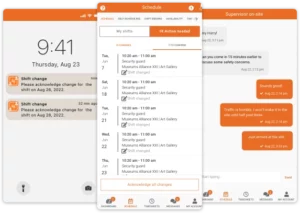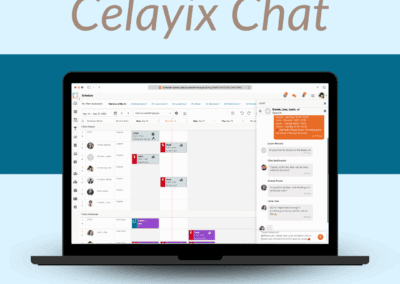What is Shift Management?
Shift management is the process of arranging employee shifts to ensure job coverage and tracking their hours. Accurately allocating and optimizing resources and teams helps ensure the right people are working, even when shift requirements or availability change quickly.
Planning employee shifts is widely used in verticals such as security, healthcare, hospitality, and manufacturing, where having the correct number and type of employees is essential.
Effective shift management solutions enable the shift scheduler to easily adapt the schedule based on requirements, availability, experience, hours worked, and preferences. The complexities of compliance, union rules, fatigue factors, and cost are better managed while enabling forecasting and analytics to improve overall operations.
Challenges of Shift Management
Unexpected worker Absences
Managers need to factor in sudden changes to their roster schedule. This can be due to either a change in business demand or workers dropping out of schedules. The change needs to be manually logged and re-communicated back to relevant workers and on-ground supervisors. This often results in missed information and no-shows.
Inability to schedule shifts at scale for a larger workforce
Managing any workforce is a challenge. When managing hundreds of workers across different locations and positions, the challenges of scheduling scale dramatically. There is a lot of data to record and many moving parts, creating a high risk of data entry errors.
Ineffective communication channels
Many managers or supervisors currently use two different platforms to create shifts and notify workers. A commonplace practice is to schedule shifts in Excel, take a picture of the sheet, and print a copy to send to workers on a group chat or post it on a notice board.
Communication via group chat is challenging to control and is often filled with irrelevant messages from other workers. This causes employees to miss crucial schedule updates.
Loss in workforce productivity due to no-shows and churn
When workers do not show up, businesses can miss productivity targets for that day. But the issue extends even further. Trust is eroded, both for business clients and for employees who would have taken the shift.
Keeping your workforce in sync with shift scheduling raises job satisfaction. If workers frequently show up to the wrong shifts, they lose time and potential income and are more likely to churn and find other employment.
Disintegrated systems and error-prone data
Manual systems are susceptible to both intentional and unintentional error. Data mismatches in shift schedules can create confusion. Employees can be misled about when staff are expected to arrive, resulting in shift no-shows, inaccurate attendance tracking, and paying the wrong amount to workers.
Similarly, disorganized spreadsheets and systems may result in errors in data reporting. The net result is the same, and attendance report errors need to be reconciled. This may take up a lot of time and may impact the accuracy or timeliness of worker payments and job satisfaction levels.

How to Simplify Shift Work
Effective shift management requires solid people skills, organizational knowledge, and strong tools.
Shift workers face a host of problems, including irregular hours, frequent location changes, a lack of culture, miscommunication, and burnout. Shift requirements vary and can include compliance with laws and regulations, union rules, fatigue constraints, and cost considerations.
Shift schedulers in complex organizations often must manage multiple locations and rapidly changing circumstances. Understanding employee needs and company demands requires both empathy and operational skills.
When it comes to determining shift requirements and preparing your business, the right software can help. Automating schedules makes them more efficient and less time-consuming for employers. This helps ensure accurate headcount based on demand, leads to far fewer schedule changes, and, in turn, happier employees.
Here are some of the standard features of Employee Scheduling software that make shift management easier.
Tailored schedules that are generated based on employee preferences (e.g. shift length, days, locations, and availability).
Real-time text & video messaging features, including conducting visual walkthroughs of new procedures.
Scaled pay, which automates different pay rates to the same employee according to the job they are fulfilling, as well as the location they are in.
Mobile apps allowing employees to clock in and out of work, as well as start and end breaks with the touch of a button on their phone.

Tools and Services to Optimize Shift Management
Efficient scheduling saves time and effort on creating, communicating, and adapting shifts.
Choosing the correct Employee
Intelligent scheduling enables managers to select employees best suited for the job at hand. They can roster their employees monthly, weekly, or daily based on specific attributes which demonstrate their experience and competencies.
A rules engine facilitates the scheduler to control which rules are followed or relaxed in specific scheduling situations. Some of the rules to consider include overtime, union and collective bargaining, qualifications and age restrictions.
This prevents unqualified employees from being scheduled for jobs they cannot perform
Employee Self-scheduling
Employees can select their own shifts. Managers can send out available shifts, and employees can choose the shifts they like, taking responsibility away from them. The workers appreciate the autonomy, while the scheduling burden is reduced for the scheduler.
A rules engine ensures that only employees who meet all the criteria will see the shift available for self-scheduling.
Artificial Intelligence (AI)
Artificial Intelligence uses state-of-the-art Machine Learning technologies to analyze past employee scheduling performance and determine which employees are best suited to a new shift schedule.
Find a Replacement
Robust shift management software quickly resolves unexpected shift drops, no-shows, sick calls, and other emergencies by providing a list of available, qualified replacements. It can either reassign immediately to your preferred choice or send a request to schedule the first or best responder.
Autofill
To further automate the shift assignment process, schedulers can use Autofill.
Autofill works as the name implies. Once the shifts have been created and entered into the schedule (or inserted via a shift template), autofill can be run to fill the shifts. Essentially, this is a set-and-forget strategy or more likely a “set and go do other tasks” approach. This approach can save the scheduler significant time, as they do not need to fill each shift themselves. Instead, they can let the system automate the assignment process.

Improve the Shift Management Process
For many businesses, shift workers are critical. Improvements in shift management improve staff utilization, empower the workforce, and increase the efficiency of HR and Operations. These enhancements help staff retention, drive margins, and boost productivity.
With effective shift management in place, businesses are better positioned for scalable execution and to provide service excellence.




